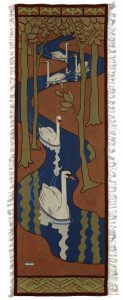
Otto Eckmann (1865–1902)
Pfeilerbehang »Fünf Schwäne«, 1897 / Column curtain »Five Swans», 1897
The column curtain »Five Swans« by Otto Eckmann is one of the most famous textile works of Art Nouveau. Already much admired at that time and printed in numerous art magazines, the Chemnitzer Kunstgewerbeverein acquired a copy during the Paris World Exhibition in 1900 directly from the Scherrebek School of Arts and Crafts for 250 marks. The blue-white-red woven stamp in the lower left corner symbolizes the Schleswig-Holstein flag and served the Scherrebek School of Arts and Crafts as protection against illegal imitation. Only licensed weavers were allowed to use the woven mark. The wool came from their own sheep breeding, was spun by themselves and dyed with vegetable dyes. In addition to Otto Eckmann, Hans Christiansen, Heinrich Vogeler, Walter Leistikow, and Henry van de Velde provided designs for the art weaving school. The Chemnitz »Swan Carpet« was first presented in September 1900 in the exhibition rooms of the model collection opened on November 15, 1898 in Waisenstraße 2 (corner house Königstraße).
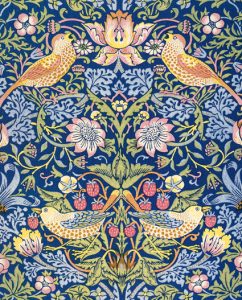
William Morris (1834–1896)
»Strawberry Thief« (Erdbeerdieb), 1883
Morris & Co., Merton Abbey, Surrey
The printed fabric »Strawberry Thief« is one of the commercially most successful and popular motifs by William Morris. It is a time-consuming and costly indigo etching technique. The cotton fabric was first dyed completely blue in an indigo bath and then printed with a bleaching etching solution in the first printing pass, leaving the pattern white or light blue. Natural colors and wood models were used for the subsequent printing processes. For this purpose, the areas to be printed were provided with a stain which served to absorb the ink. The light green was created by overprinting yellow on light blue and the orange by overprinting red and yellow. The excess color of the unstained areas was finally washed out in a hot soap bath. The entire process was manual and was carried out at Merton Abbey. In addition, the fabrics were spread out on the meadows and exposed to sunlight for bleaching.
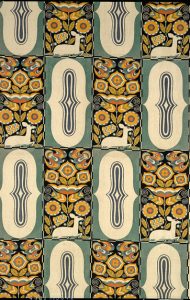
Carl Otto Czeschka (1878–1960)
Druckstoff »Waldidyll«, 1910/11 / Print fabric »Forest Idyll«, 1910/11
The Austrian painter and graphic artist Carl Otto Czeschka was one of the most important designers of the Wiener Werkstätte. He participated in the Gesamtkunstwerk Palais Stoclet in Brussels and supplied a total of fourteen patterns for the fabric department of the Wiener Werkstätte. He designed this printed fabric with the melodious name »Forest idyll« in 1910/11, when he was already working at the School of Arts and Crafts in Hamburg.
The motif was printed on silk or linen and used as a decoration and clothing fabric. A historical photograph from 1916 shows Gustav Klimt wearing a robe made of this fabric on the occasion of an artists’ festival in the Primavesi house, which was also used for one of the guest rooms in the house. The fabric was acquired in 1913 for the Chemnitz collection.
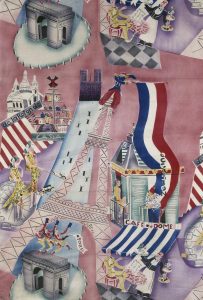
Maria May (1900–1968)
Spritzstoff »Paris«, 1930 / Spray-on fabric »Paris«, 1930
From 1921 to 1931 Maria May headed the textile class at the Reimann School in Berlin, one of the largest private schools for art and applied arts in Germany. Her spray-on decorative fabrics, the so-called May fabrics, were particularly popular. The motifs were sprayed onto the textile fabric using stencils. The design of this fabric was created during a study stay in Paris and shows the typical tourist motifs of the city. May also experimented in cooperation with the IG-Farben-Industrie. She later moved to Hamburg, where she headed the master school for fashion.
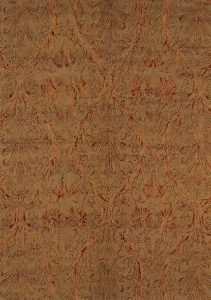
Mariano Fortuny (1871–1949)
Druckstoff, ca. 1930 / Print fabric, ca. 1930
Societá Anonima Fortuny, Guidecca
The fabrics of Mariano Fortuny are characterized by perfect craftsmanship. Before the actual printing process, they usually went through a multi-part dyeing process using natural colors and also bronze and aluminium powder. This printing fabric decorated the walls of the gaming room in the Hotel Excelsior at the Lido. The hotel was mentioned by Thomas Mann in the novella »Death in Venice« and gained fame at the Venice International Film Festival.
Mariano Fortuny loved historical fabrics, especially Renaissance fabrics, which inspired him.
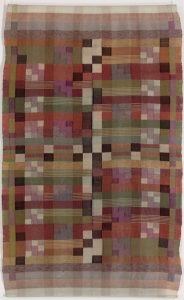
Benita Koch-Otte (1892–1976)
Behang, 1922/1924 / Tapestry, 1922/1924
Staatliches Bauhaus Weimar
Benita Koch-Otte executed the tapestry at the Weimar Bauhaus. By partially dyeing the warp threads, interesting color gradations of the extremely refined pattern were created. Koch-Otte was inspired by Paul Klee and did not create a narrative tapestry, but a two-dimensional, constructive composition. Together with Gunta Stölzl, she attended a dyeing course in 1922 and a so-called manufacturer’s course in Krefeld in 1924. In addition to calculation and patronage, the focus was on the theory of weaving, an essential prerequisite for the implementation and understanding of textile techniques.

